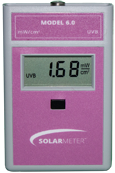SOLARMETER ® 6.0 UVB
The Model 6.0 features an Integral Sensor and applications include lamp UVB intensity & aging, acrylic shield transmission, percent (%) UVB if divided by reading from Model 5.0, eyewear UV block comparisons.
| Specifications | Radiometer |
| Model | 6.0 |
| Irradiance Range | 0-19.99 mW/cm² UVB |
| Response | 280-320 nm |
| Resolution | 0.01 mW/cm² |
| Conversion Rate | 3.0 Readings/Sec |
| Display | 3.5 Digit LCD |
| Operating Temps | 0° C to 40° C |
| Operating Humidity | 5% to 80% RH |
| Accuracy | ±10% REF.NIST |
| Dimensions (LxWxD) | 10.5 x 6 x 2.2 cm |
| Weight | 110 Grams |
| Power Source | 9-Volt DC Battery |
| Lens | UV Glass |
| Diffuser | Virgin Teflon .005 |

To enquire on the the Model 6.0 please click on the link below or use the contact page.
When requesting a quote please provide quantity and suburb/state for postage/delivery details.
Sensor- Silicon Carbide (SIC) Photodiode packaged in hermetically sealed UV glass window cap.Interference filter coating (Metal Oxide) blocks most UVA from response as shown on Spectral Sensitivity Graph.
Operation
Press and hold push-button switch on face of unit. Aim sensor window in top panel of meter directly at UV source. Note reading on LCD and record if desired.
Battery operation voltage is 9V down to 6.5V. Below 6.5V the LCD numbers will begin to dim, indicating the need for battery replacement. Under "typical" service load, the battery should last about 2 years.
Operation
Press and hold push-button switch on face of unit. Aim sensor window in top panel of meter directly at UV source. Note reading on LCD and record if desired.
Battery operation voltage is 9V down to 6.5V. Below 6.5V the LCD numbers will begin to dim, indicating the need for battery replacement. Under "typical" service load, the battery should last about 2 years.
Proper Usage of Solarmeter ® Ultraviolet Radiometer for Lamp Aging Tests
- Wear eye protection when checking UV lamps (UV-block wrap around glasses).
- Allow lamps to warm-up prior to taking readings (at least 5 min).
- When checking aging of lamps, keep measuring distance and locations constant.
Note: Model 5.0 (UVA + B) is best for lamp aging tests.
- Lamps should be replaced when output drops 30% to about 70% of their original (new) readings. Take overall reading center of tanning bed bench pointing up with canopy closed, or check individual lamps at acrylic with canopy up. Keep track of hours vs. readings on a chart.
- If unsure of what original new values were, replace two adjacent lamps with new ones of the same kind and compare to old ones.
- To determine percent UVB divide Model 6.0 reading by Model 5.0 total UV (UVA + B) reading. (See FAQ page).
- When checking acrylic transmission, take reading through acrylic; then remove acrylic and hold meter sensor at approximately the same distance from lamp as the acrylic shield was located. If acrylic blocks much UVB it should be replaced.
- When using this meter to compare different type lamps, due to their different spectral power distributions, the readings should be considered relative rather than absolute. Although higher output lamps of similar SPD's will generally read higher than lower output lamps, ones that peak near 290-300 nm (as does the meter response) will read higher than ones peaking near 313 nm even if the total UVB output of both is the same.
- Do not subject the meter to extremes in temperature, humidity, shock or dust.
- Use a dry, soft cloth to clean the intrument. Keep sensor free of oil, dirt, etc.





















